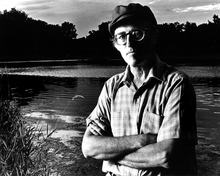Eville Gorham
| Eville Gorham | |
|---|---|
 Gorham in 1984 | |
| Born |
15 October 1925 Halifax, Nova Scotia, Canada |
| Residence | USA |
| Citizenship | Canada, US |
| Fields | Ecology, Limnology, Biogeochemistry |
| Institutions | University of Minnesota |
| Alma mater |
Dalhousie University University College London |
| Doctoral advisor | W. H. Pearsall |
| Known for | Studies of acid rain, peatlands, radioactive fallout |
| Notable awards |
Benjamin Franklin Medal[1] G. Evelyn Hutchinson Award[2] Lifetime achievement award, Society of Wetland Scientists |
Eville Gorham (PhD LlD DSc FAAAS FRSC MNAS FESA) is a Canadian-American scientist whose focus has been understanding the chemistry of fresh waters and the ecology and biogeochemistry of peatlands.[3] In the process, Gorham made a number of practical contributions that included discovering the influence of acid rain in lake acidification,[4][5] plus the importance of the biological magnification of radioactive fallout isotopes in northern food chains.[6][7][8][9] The former led to legislation and redesign of the power plants of the world to scrub sulfur, and the latter was an early step toward the establishment of an atmospheric nuclear test ban treaty.
Gorham emphasizes that discovery in science is often the result of chance and serendipity, and encourages students to watch for the opportunities that chance provides.[10] He was recognized by the National Academy of Sciences[11] as a renaissance scholar[12] and has influenced the careers of others.[13]
Life and career
Gorham grew up in Halifax, Nova Scotia, an avid reader drawn to the classroom. His life and career are outlined in a 2015 essay.[14] Briefly, he attended Dalhousie University from 1942 to 1947, receiving a BSc degree in biology and an MSc degree in zoology. His thesis showed the effects of temperature difference in the development of salmon embryos,[15] of later significance for studies of thermal pollution.
At this point, Gorham decided to avoid experimentation that involved harming animals. In 1947, he received an Overseas Science Research Scholarship from the Royal Commission for the Exhibition of 1851 and was accepted as a doctoral student of plant ecology at University College, London. In 1948, he married Ada MacLeod, whom he had met while she was researching child nutrition at Dalhousie.
Gorham began his doctoral work studying mineral content of plants in the Lake District and became interested in the acidification of ecosystems. After his PhD, he spent a postdoctoral year in Sweden conducting a project on the waters of a Swedish peatland. After returning to England, he worked for the Freshwater Biological Association in the English Lake District. It was here that he made some of his most significant discoveries regarding acid rain and nuclear fallout.
After the death of his father, Gorham and family returned to Canada, where he took a position in the botany department position at the University of Toronto. With Alan Gordon, he studied the effects of smelter pollution on the forests and lakes around Sudbury. Then in 1962, he accepted a position at the University of Minnesota. It was here that Gorham took up environmental activism and developed courses on the ecological effects of pollution upon ecosystems. Gorham served on multiple environmental committees, including the joint Canadian-U.S. scientific commission under President Carter,[16] and took part in many environmental projects, such as those sponsored by the Royal Society of Canada and U.S. Academy of National Sciences.
Selected Works
References
- ↑ Platt, Lucian (2000). "The 2000 Benjamin Franklin Medal in Earth Science presented to Eville Gorham". Journal of the Franklin Institute. 337 (7): 813–816. doi:10.1016/S0016-0032(00)00058-2.
- ↑ Nixon, Scott W. "Hutchinson Award to Eville Gorham". Eos, Transactions American Geophysical Union. 68: 199. Bibcode:1987EOSTr..68..199N. doi:10.1029/eo068i014p00199-01.
- ↑ Gorham, Eville; Lehman, Clarence; Dyke, Art; Clymo, Dickie; Janssens, Jan (2012). "Long-term carbon sequestration in North American peatlands". Quaternary Science Reviews. 58: 77–82. doi:10.1016/j.quascirev.2012.09.018.
- ↑ Gorham, Eville (1955). "On the acidity and salinity of rain". Geochimica et Cosmochimica Acta. 7: 231–239. doi:10.1016/0016-7037(55)90034-x.
- ↑ Schobert, Harold H. (2014). Energy and Society: An Introduction, Second Edition. CRC Press. p. 478ff.
- ↑ Gorham, Eville (1958). "Accumulation of radioactive fallout by plants in the English Lake District". Nature. 181: 152–154. doi:10.1038/1811523a0.
- ↑ Gorham, Eville (1959). "A comparison of lower and higher plants as accumulators of radioactive fallout". Canadian Journal of Botany. 37: 327–329. doi:10.1139/b59-023.
- ↑ Kaufman, Scott (2013). Project Plowshare: The peaceful use of nuclear explosives in Cold War America. Cornell University Press. p. 76.
- ↑ Young, Wayne (2014). "Life in the fast lane– what’s the rush?". The Guardian, Charlottetown Newspaper.
- ↑ Gorham, Eville (2012). "Two contrasting approaches to ecological research". Ecological Society of America Bulletin. 93: 298–302. doi:10.1890/0012-9623-93.4.298.
- ↑ https://www.fi.edu/laureates/eville-gorham
- ↑ National Academy of Sciences (1995). "Presentation Ceremony". Proceedings of the 132nd Annual Meeting. 123.
- ↑ Vitousek, Peter (2014). "Insightful, scholarly, and synthetic: Eville Gorham and the chemistry of surface waters". Bulletin of the Ecological Society of America. 95: 226–228. doi:10.1890/0012-9623-95.3.226.
- ↑ Gorham, Eville (2015). "Reflections on life in a deteriorating world: How chance made me an environmental activist.". Journal of Opinion, Ideas, and Essays (online). 2: 1–15.
- ↑ Hayes, Ronald F.; Pelluet, Dixie; Gorham, Eville (1953). "Some effects of temperature on the embryonic development of the salmon (Salmo salar)". Canadian Journal of Zoology. 31: 42–51. doi:10.1139/z53-005.
- ↑ Hayes, Samuel (Feb 1, 1998). Explorations in Environmental History: Essays. Pittsburgh, PA: University of Pittsburgh Press. p. 281.
External links
- Eville Gorham, University of Minnesota, College of Biological Sciences
- Collected works, Digital Conservancy
- Citations to works, Google Scholar
- Interview, with S. Mandaville, In Harmony with Nature
- Interview, with Clarke Chambers
- Interview, with C. Lehman, University of Minnesota
- Honorary doctorate, University of Minnesota
- Franklin Institute
- Summary of Career